Must watch Japanese YouTube channels for business
February 20, 2019
YouTube’s popularity has greatly grown within these years in Japan.
There seems to be more people searching on YouTube rather than Google, especially on finding a way to do something. However, in fact, many of YouTube channels in Japan are made for young generation, not for business use. So this time, I will introduce my recommendation of Japanese YouTube channels for business persons.

Horiemon channel
https://www.youtube.com/channel/UCXjTiSGclQLVVU83GVrRM4w
A channel by Mr. Takafumi Horie, a famous IT entrepreneur commonly known as “Horiemon”.? There are a lot of fan of him, however, some people do not like him very much because of his frankness of speech. He is extremely well briefed on various business, not only IT business, but also rocket, gourmet and so on. In this channel, Mr. Horie discusses new business ideas with people in vogue such as best-selling authors. Also, he answers various questions from the readers of his mail magazine that gives beneficial ideas for business. This channel is updated frequently and well-organized.
NewsPicks
https://www.youtube.com/channel/UCfTnJmRQP79C4y_BMF_XrlA/featured
A channel by News Picks, which is a content curation media for business. (I introduced NewsPicks in this article https://goo.gl/ih8A8b ) Many business talks with well-known entrepreneurs and innovators are up on this channel.
There are also videos (https://www.youtube.com/watch?v=XOlE7uqvvLE)of Mr. Kosaka known as “Pico-Taro” who is famous for “”Pen-Pineapple-Apple-Pen”. He talks about the hidden story of Pico Taro’s birth. Japanese subtitle in this channel is excellent, so it will help your listening practice as well.
TEDXTOKYO
https://www.youtube.com/user/tedxtokyo/videos
A channel of TEDxTokyo which is the Japanese version of TED.
Although quality and quantity of this program are inferior to the above two, it will be helpful for those who are interested in an interview and a presentation in Japanese.
Industry Co-Creation
https://www.youtube.com/channel/UCJg5PAsj8fP45Fn8Pr5a3LQ/featured
Industry Co-Creation is an entrepreneur conference that is gathering of company founders and business leaders. Movie of pitch events is the main content of this channel. This channel will be helpful for those who are interested in an elevator pitch or a presentation.
BBT 757 program
https://www.youtube.com/user/BBT757program
A channel of online university “Business Breakthrough University (BBT)”, presided by a well-known management consultant, Mr. Kenichi Ohmae. It covers such topics as MBA, business news, and business trends.
Sekai wa ima – JETRO Global Eye
https://www.youtube.com/channel/UC7yNsJvQ0wMOh6cdtUajLXQ
A channel of JETRO (Japan External Trade Organization) which supports overseas expansion of Japanese companies. A content format of the channel is like a real TV news program, and the narration is made by a professional narrator who speaks beautiful Japanese.
It is especially recommended for people involved in trade.
Kigyoo TV
https://www.youtube.com/channel/UCeKbsDj3ESBP5VuYTItN35w/featured
A channel of “Kigyoo TV”, a movie learning media for entrepreneurs.
The main contents of this channel is interviews of venture-business entrepreneurs.
All the channels I introduced this time are useful not only for Japanese listening practice but also to your business. So check them out!
PS
I will introduce another channel as an extra edition.
Dad has naturally curly hair
https://www.youtube.com/user/masatoikebe/featured
A family channel of “VAN LIFE”, “Vehicle Night” enjoying outdoor such as hiking, surfing, skiing, snowboarding. There is no useful business information, however, I recommend this channel for people who want to enjoy outdoor activities with family in Japan.
There are many information on ski resorts, travel stories from Chiba to Hokkaido by car, and so on.
Are Automatic Captions on YouTube so accurate?
January 17, 2019

I introduced the live caption and subtitles feature for Skype in the previous article, so this time I would like to share with our readers the Auto Translate Captions on YouTube.
To test the auto translate captions on YouTube, I chose a video that TV Tokyo’s popular news program called “World Business Satellite” introduced our company (Japan Online School).
The following six people (A to F) appear in that video.
A: Japanese / narrator / male
B: Japanese / narrator / female
C: Japanese / Japanese teacher / female
D: Japanese / company manager / male
E: Foreigner / male (Japanese Level = Intermediate)
F: Foreigner / female (Japanese level = advanced)
Here is a compilation video of YouTube’s automatic captioning based on the original speech.
The accuracy rate of automatic captioning in each 6 patterns (A to F) was as follows.
A: Japanese / narrator / male: 81.8%
B: Japanese / narrator / female: 97.3%
C: Japanese / Japanese teacher / female: 88.6%
D: Japanese / company manager / man: 87.3%
E: Foreigner / male (Japanese level = intermediate): 56.6%
F: Foreigner / female (Japanese level = advanced): 85.7%
Concerning the average accuracy rate, native Japanese speakers (A to D) achieved 87.0%, while non-native Japanese speakers (E & F) of 65.2%. As expected, recognition of native speakers’ speech is more accurate than non-native speakers.
Also, the results varied even among foreigners; Ms. F who has almost native level proficiency in Japanese was recognized with high accuracy, while Mr. E with intermediate level was recognized only about half of his speech.
As in the following cases, there were some sentences that became completely wrong meanings from the original.
〇 <Buchoo>, chotto <yoroshii> deshooka.
(Department manager, is it okay?)
× <Moochoo>, chotto <dooji> deshooka.
(Cecum slightly at the same time)
○ Tokyo<Shoji> e dasu kikakusho nandesuga, <me o tooshite> itadakenaideshooka.
(This is a proposal for Tokyo Shoji. Could you please check this for me?)
× Tokyo<Soojigen> e dasu kikakusho nandesuga, <fuufu o twitter> itadakenaideshooka.
(This is a proposal for Tokyo Soojigen. Could you please tweet a couple for me?)
Although the automatic captioning can be affected by background noise and video’s audio quality, the accuracy rate of two foreigners (Mr. F and Ms. E) was almost equivalent to speaking fluency evaluated by a professional Japanese teacher.
Therefore, I can say that those whose speech is correctly recognized by YouTube’s automatic captioning have a considerably advanced level of Japanese.
So please give it a try (^ ^) /
※Accuracy level of automatic captioning on YouTube varies depending on contents of programs.
It recognizes such programs as news and dramas of which texts are mainly based on script more accurate. On the other hand, comedy shows and live interviews are less accurate.
※ This information is as of January 11, 2019.
Could the live caption and subtitles feature in Skype tell how accurate your Japanese is?
December 17, 2018
On December 3, Microsoft announced the launch of live captions & subtitles feature for Skype. The feature is already available for Japanese version. I think this new feature is useful for all Japanese learners, so I will introduce to you this time.
How to use the feature?
Please refer to the following SKYPE’s official sites.
Japanese version
English version
What’s the level of accuracy of the feature?
Frankly speaking, the feature is not so perfect yet.
Even when two Japanese people converse in Japanese, it was inaccurate.
I think that the feature’s usefulness is limited by its accuracy, therefore, I do not recommend using the feather to make an online meeting, to transcribe its contents, and to make minutes.
How to use the feature effectively
In a free talk, accuracy level was not so high, however, it was much better when reading the script. So it might be a good way to use the feature for practicing reading fluency. If Skype puts captions incorrectly, it means the way of reading Japanese is not perfect, and the listener may misunderstand. The feature would also help you to analyze your weak points in reading Japanese.
These are the live captions I tried for the first time.
Please check them in the picture.
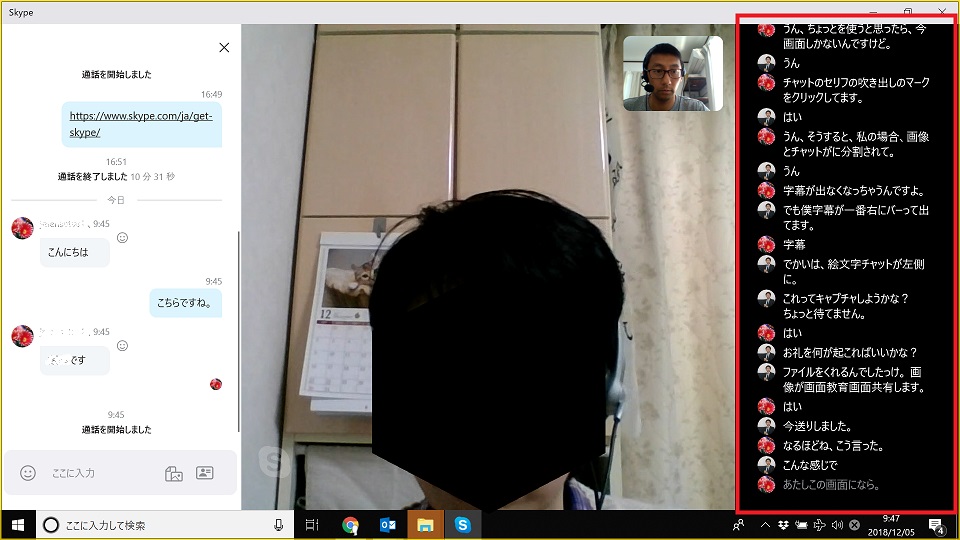
Note: This information is as of December 10, 2018. Let’s pay attention to the further improvement.
What would be a barometer of public safety in Japan?
November 19, 2018
As I wrote in the last newsletter, the Japanese are very proud of the fact that there are many vending machines operating safely in Japan.
However, there are actually a lot of vending machine burglars in Japan.
Especially, a photo booth, a cubicle room in which a person closes the curtain, and sits to have photograph taken by a machine, is easily targeted by thieves.
Also, on Halloween day at Shibuya this year, there were some people going on a rampage, and arrested on suspicion of molestation, taking photos secretly, or rolling over a car.
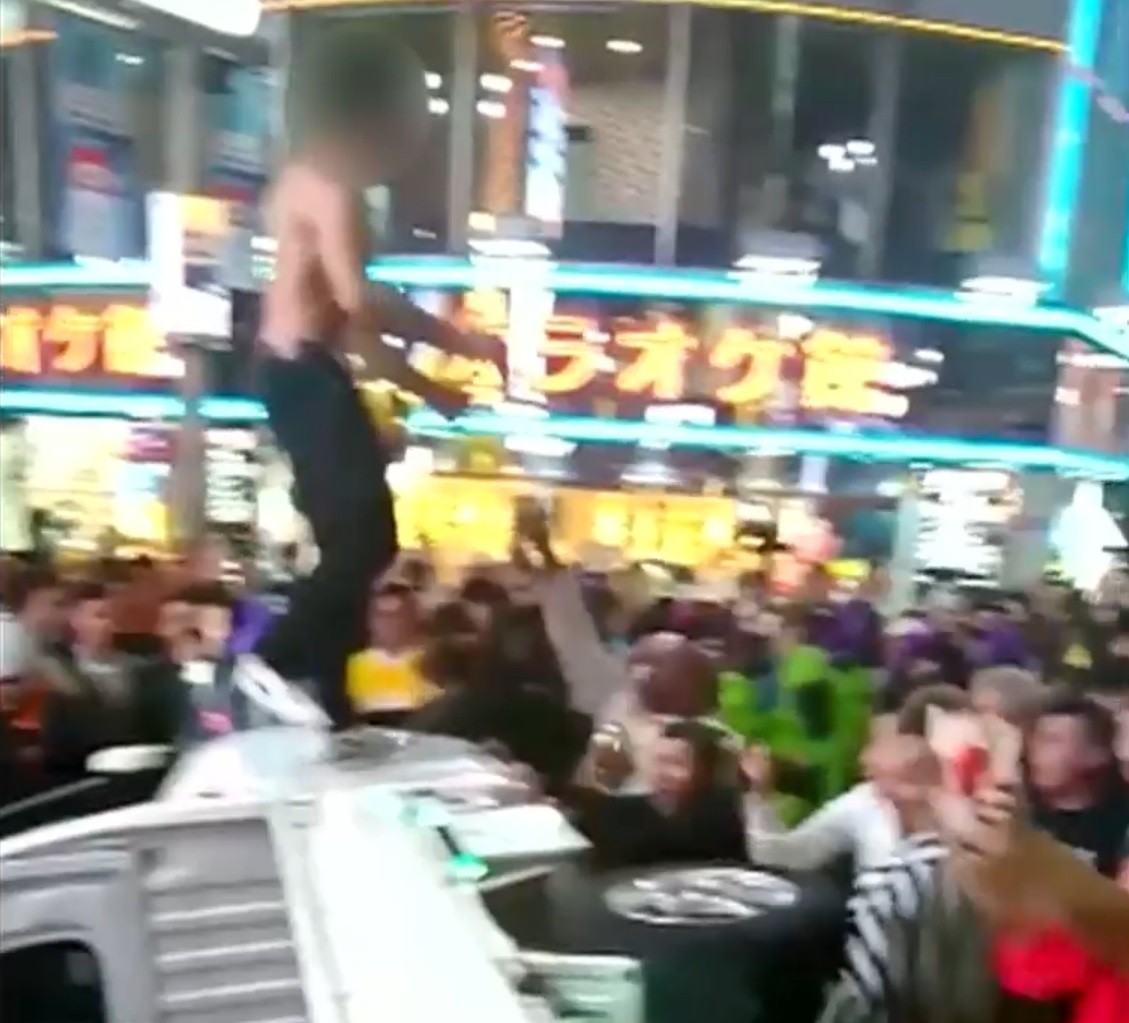
Therefore, I would like to talk about a barometer of public safety in Japan.
One of my friends says that “If you look at the toilet of convenience store, you will know the public safety of the area.” Depends on a sign hanging on the toilet door, you will see how safe the neighborhood is, he insists.
If a sigh says;
- “Please feel free to use” = Safe neighborhood
- “Please notify our staff before using” = Normal
- “Do not use” = Rough area
According to another friends of mine, “Trash box of convenience stores can also be a barometer of security.”
He says that “the neighborhood where the trash box put outside can be an evidence that there are many customers who keep the rules. Therefore, security of the area is good.”
From my perspective, the neighborhood with many flower and cake shops are relatively safe, because flowers and cakes are bought more likely for gifts to others.
I logically believe that there are many people who can do something for other people in areas with many flower shops and cake shops.
What is a barometer of public safety in your area?
If you have any other opinion, please let me know.
*Please note that this is just a personal opinion. It would vary in urban or rural areas, commercial area or residential area. So, please read this article just for reference.
The best place for tourists and consumers where they can enjoy both visual and taste.
October 18, 2018
Today, I would like to introduce the spots that both people who live in Japan and those who come by travel can enjoy it.
Have you heard the word “depa chika”?
“depa chika” is an abbreviation for “basement of a department store”.
The underground of most department stores in Japan has become a sales floor of food materials and sweets.
Usually, department stores sell better products than supermarkets.
Alothough most of products in department store are a little expensive,there are many people who go shopping at depa chika as a little treat for themselves.
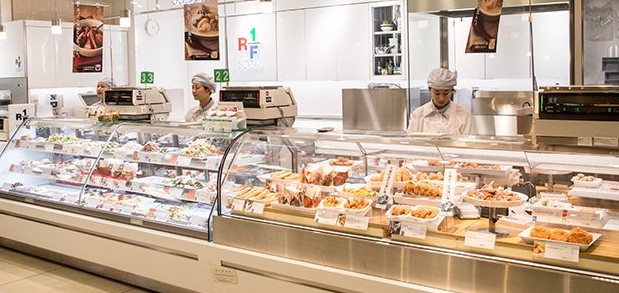
Four reasons to recommend depa chika
Reason 1: Only in Japan
I think that it is unusual for all of the department store’s one floor to be food and sweets.
If you like eating and drinking, you surely will have a good time in depa chika for one or two hours.
Reason 2: Clean look
Food is displayed beautifully, so it is fun just looking.
Reason 3: Deliciousness
Many delicious foods are gathered in depa chika.
There are times when local specialties in Japan are sold, so you do not have to go out to the region to buy them.
Moreover, you might be able to try them. (Please keep good manners in this case.)
Reason 4: Cheapness
I said as “department store is a bit higher than the supermarket”, but these products are very delicious and I think it is much cheaper than the overseas luxury supermarket.
When I went to Hawaii the other day, I have seen the Whole Foods’ Deli corner, but I thought that Japanese department store is cheaper.
If you think that it is a sightseeing spot you can enjoy for free, it is advantageous.
If you want to buy it cheaply, the time zone just before closing is recommended.
There is a high possibility that popular products are sold out, but the remaining products may be discounted.
This is the official Instagram of department store called Tokyu in Shibuya.
https://www.instagram.com/tokyufoodshow/
In this YouTube, foreigners are introducing Japanese depa chika.
Since this site organizes department stores across Japan, it is convenient to find a department store nearby.
http://www.departinfo.com/english/
(Please check in advance whether there is a depa chika.)
Please go to depa chika where you can enjoy both visual and taste (^ ^) /
How many reasons are there why many vending machines exist in Japan?
September 18, 2018
Many people know that there are many vending machines in Japan.
There are also vending machines that sell not only drinks and tobacco but also ice, cup noodles, candy, bananas, pizza, books, umbrellas, diapers, crepes and so on.
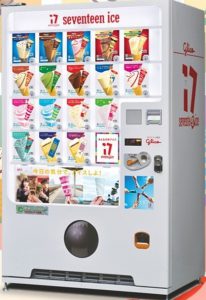
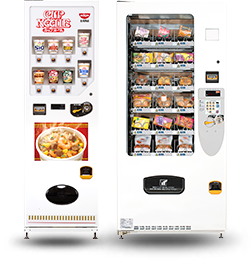
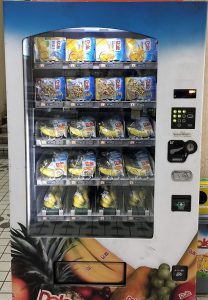
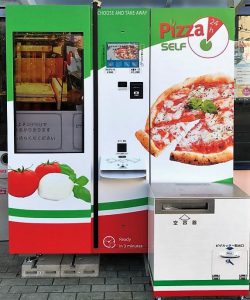
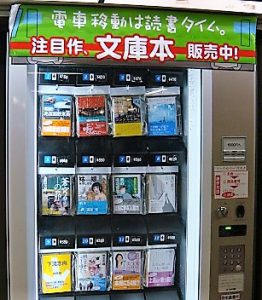
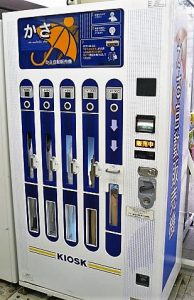
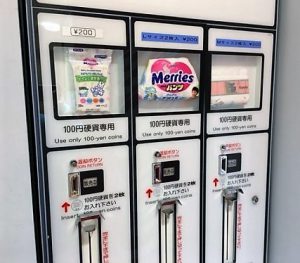
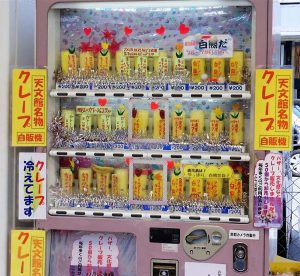
* Aside from that, in the event of a disaster such as an earthquake, there are many vending machines with offering the products (mainly drinks) contained free of charge.
Vending machines that brew drip coffee are also popular.
https://www.youtube.com/watch?v=TFSi2b1LPMQ
The most surprisingly, there is a vending machine that sells wedding rings. It seems there are people who propose while going out and buy them immediately after that.
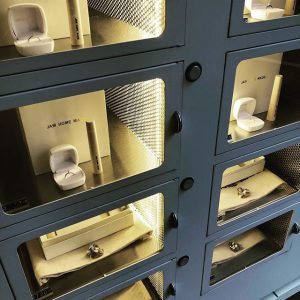
By the way, how many reasons are why many vending machines exist in Japan? (please read the following after considering the reason, )
https://www.youtube.com/watch?v=9UJzVLXmBG4
In this movie, in addition to the safeness in Japan, other reasons are mention, for example “high population density”, “personnel expenses of salespeople is high”, “cash society (often using coins)” “Japanese like robots and machines”
Besides these, there are the following reasons.
“Summer is hot” By the way, sales of vending machines are peak in summer, and in winter there is only half of sales in summer.
“Landscape rules are not strict”
“The beverage maker lends a vending machine to the land owner for free.” The owner of the land gets a commission according to the sales amount from the beverage maker, so you can start a no-risk business on a narrow land.
Do you have the same reasons?
In this way, thinking as “what’s the reason?”, is helpful for business as well, and comparing it with other countries will help you to rediscover the uniqueness of Japan.
Either way, the primary reason for existing so many vending machines in Japan is that Japanese public security is extremely good. I hope that Japan will be safe from now on.
Three points when telling the message to Japanese people / British who uncover “inconvenient truth” in Japan
August 17, 2018
Do you know David Atkinson?
The other day, I had the opportunity to hear his lecture, and I also read his books, I got a new awareness. Therefore, this time, I will introduce him.

(1) Who is David Atkinson?
His bio is as follows. (Some excerpt from Wikipedia)
———————————
He learned Japanese studies at Oxford University. He worked for Andersen Consulting (the predecessor of Accenture) and Solomon Brothers and came to Japan around 1990. In 1992 he moved to Goldman Sachs and worked as an analyst, pointed out a huge amount of bad debts sleeping at Japanese banks after the collapse of the bubble economy. After being promoted to a partner in 2006, he left the company in 2007.
After retiring from analysts and devoting to Japanese tea ceremony, he joined Konishi Arts & Crafts Co., Ltd., which is repairing Japanese national treasures and important cultural properties, in 2009. In 2010 he became chairman of the company. After that, as an expert of Japanese cultural assets, he also makes suggestions on Japanese cultural property policies and tourism policies. From June 2017, assumed the special adviser of Japan National Tourism Organization.
———————————
(2) What is the inconvenient truth of Japan that Mr. David Atkinson exposes?
In his book “新・所得倍増論”(new edition – income doubling theory), he pointed out the low productivity of Japan.
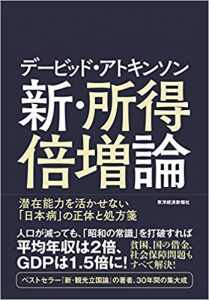
For example, we, Japanese people have been heard the brilliant achievements of the Japanese economy as follows.
———————————
GDP = 3rd in the world
Export value = 4th in the world
Number of Nobel laureates = 7th in the world
———————————
However, he insists that “Because these are all influenced by the high population of Japan, we should see per capita figures, not absolute numbers.” Therefore, when looking at the above three items “per capita”, it turns out
———————————
GDP = 27th in the world
Export value = 44th in the world
Nobel laureate winners = 39th in the world
———————————
and it is never a special country.
For reference, the export value is only 48% of Germany (3rd in the world). Moreover, since the population of Japan is 1.6 times more than Germany, the per capita export value of Japan is only 1/3 of that of Germany.
He mentioned the incompetence of Japanese executives as follows, touching on Japan’s population decline problem.
“Japan was booming in the 1970s not because Japanese executives were excellent because they benefited from population bonus due to the rapid increase in population. When the population declined in the 1990s, it was necessary to completely change the way of economy, but Japanese executives did not recognize it. In Japanese-style management so far, emphasis was placed on “management” of things. It is fine for the time of constant growth, but now is different. Despite the fact that there are the most competent workers in the world, Japanese executives who showed only the lowest productivity in developed countries can be said to be ‘crisis’. ”
(3) Three points when telling the message to Japanese people
I was able to take the above-mentioned “inconvenient truth” obediently. I think that there are the following reasons.
- He uses objective data.
- He is familiar not only with the Japanese economy but also with Japanese culture.
- We can feel his passion of “I want to improve Japan”
And I think, these three points are also important when non-Japanese people persuades or advises the Japanese. For example, when you suggest something to your Japanese boss or Japanese management or Japanese clients, if you clear these three points, the success rate will be high.
デービッド・アトキンソン 新・所得倍増論
(ISBN-13: 978-4492396353)

デービッド・アトキンソン 新・観光立国論
(ISBN-13: 978-4492502754)
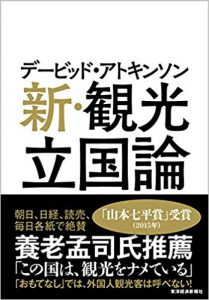
For those who are involved in inbound business, this book is also recommended.
It is recommended to read Japanese business magazines for business Japanese learning. Newspapers are also good, but since there are many new topics, the information can be sporadic, so the magazine is better to intensively read topics of interest in feature articles etc. Besides, information is useful for business, so it is two birds with one stone.
So, I tried searching for business magazines at Fujisan, a Japanese No1 online bookshop for magazine’s, but I hit 1375 cases! Too many to choose best one. Although it is recommended to go to a bookstore and actually see the contents, it is also hard to compare all magazines.
So this time, I will introduce the top 5 business magazines sold in Japan and 5 other recommended magazines, totaling I selected 10 magazines.
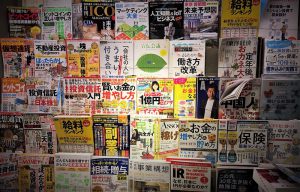
The sales circulation TOP 5 from January to March 2018 is as follows. (*2)
No1: PRESIDENT (319,933 copies)
In 1963 it was launched as the Japanese edition of FORTUNE USA. For managers and business leaders. Publication twice a month. It deal with a wide range of subjects ranging from high quality business information, skill ups and lifestyle.
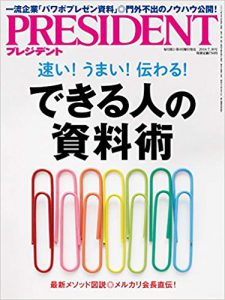
Buy this at Amazon / Buy this at Fujisan
No2: Weekly DIAMOND (週刊ダイヤモンド:125,833 copies)
First published in 1913. A business weekly magazine that is most popular in bookstores. In addition to economic, financial, and corporate information, it has plenty of diverse serial articles and columns.
There are also many contents for young employees.
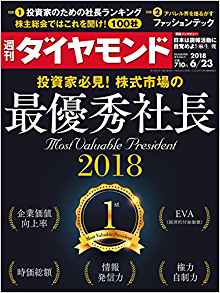
Buy this at Amazon / Buy this at Fujisan
No3: Weekly TOYO KEIZAI (週刊東洋経済 : 90,250 copies)
First published in 1895. Feature articles on seasonal themes and of various companies, there are many useful information for all generation including a student in job hunting. You can grasp the latest topic of the Japanese economy.
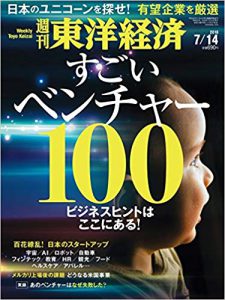
Buy this at Amazon / Buy this at Fujisan
No4: THE21 (49,400 copies)
First published in 1984. Monthly magazine. Many information is useful for self-improvement.
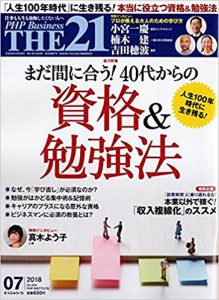
Buy this at Amazon / Buy this at Fujisan
No5: DIAMOND Harvard Business Review (ハーバード・ビジネス・レビュー : 20,700 copies)
The only comprehensive management magazine in Japan that fully cooperated with Harvard Business Review magazine in the United States. For managers and business leaders.
Sharp suggestions and explanations coming from opinion leaders are popular. It has plenty of information on strategy and analysis.
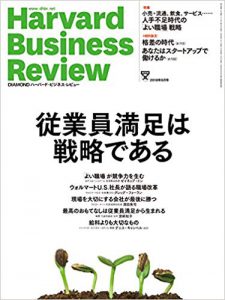
Buy this at Amazon / Buy this at Fujisan
Since all of these are dealing with a wide range of information, you can choose from your interests and positions of work.
Although it did not enter the top 5 in the number of sales, there are also many magazines that I would like to recommend. The following are some of them.
NIKKEI TRENDY (日経トレンディ)
Trendy information magazine introducing the latest trends and latest products. There are many easy-to-read contents.
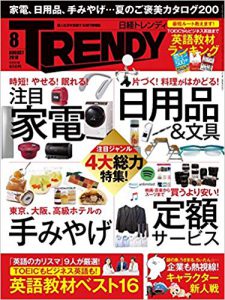
Buy this at Amazon / Buy this at Fujisan
Monthly JIGYO KOUSOU (月刊事業構想)
Professional journal on corporate activity, regional creation, innovation. Monthly magazine. For managers / new business planning staff.
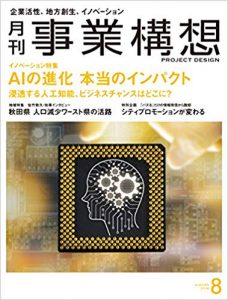
Buy this at Amazon / Buy this at Fujisan
SENDEN KAIGI (宣伝会議)
Specialized magazine of advertisement, advertisement, and marketing. Published twice a month.
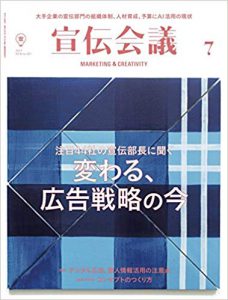
Buy this at Amazon / Buy this at Fujisan
INTERNET SALES (ネット販売)
As its name suggests, it is a specialty magazine for online sales. Monthly magazine. Since it is not sold at a bookstore, go to the following link for purchase.
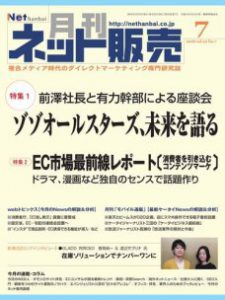
MARR(マール)
The only M & A special monthly magazine in Japan. For people involved in M & A.
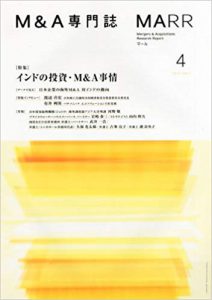
Buy this at Amazon / Buy this at Fujisan
I added links to Amazon and to Fujisan, but please note that images and links are not limited to the latest issue. At Amazon, it is easier to order one book, but at Fujisan, they offer discounts of up to 50% when subscribing. They delivers it to your home (limited to Japan only) and e-book version can also be read.
If you want to know other magazines, please consult your J-OS instructor or support team (^^)/
*1: As of July 9, 2018
*2: Source:Japan Magazine Publishers Association
Sharing economy in Japan
June 14, 2018
It became a hot topic that Airbnb canceled all reservations for properties that violate Japanese law. And it is said that there are still various problems in the sharing economy. However, as the Mercari listed soon, the sharing economy itself is growing also in Japan, so I would like to introduce Japan’s major sharing economy service this time.
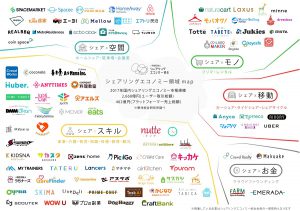
Sharing economies are generally classified into three categories: object shares, space shares, and skill share. (There are various opinions on how to classify.) The representative services of each are as follows.
(1) object shares
Mercari: The most famous in Japan as a flea market apps.
Laxus: All-you-can-use brand bags at 6,800 yen per month. Popular with young women.
Air Closet:A service that can wear three clothes chosen by a professional stylist at 6,800 yen per month.
Anyca :A service that allows you to lend and borrow a car among individuals.
If you like Initial D(Japanese manga), would not you want to drive this car?
This car that became famous by the movie “Wild Speed” should be popular.
※To use Anyca you need a driver’s license issued in Japan. International licenses are not acceptable.
(2) space shares
Space Market: Services to lend and borrow party venues, conference rooms, photography studios, etc.
Akkipa:Services to lend and borrow parking lots.
ecbo cloak:A service that introduces space that temporarily keeps luggage such as large suitcase which does not enter coin locker. The site also supports English, Chinese, Korean.
DogHuggy:A service that allows you to leave your dog at other dog-lovers. Many people use it instead of pet hotel.
(3) skill share
Basically it is a service that provides individual skills and free time, but some also provide housekeeping or manual labor. The following services are famous.
TimeTicket、Any+Times、Coconala、Street academy
There is also a service called Traveloco specializing in matching with Japanese guides living abroad.
Foreigners may seem surprising, but general Japanese people are cautious about “lending and borrowing for a fee”. (There are many people who will be kind to those in need.) There are many people who are concerned about trouble due to interaction between individuals in sharing economy. Therefore, many people think “Even if it is expensive, I will depend on the pros”.
Many of (1) are comparable to the services provided by professionals and are inexpensive, so the number of users is increasing even around me, but those who use the service introduced in (3) There is not much yet. For the service introduced in (2), users and usage frequency are limited, but there may be strong demand for specific users, specific timing.
It may be the nationality of the country to decide which sharing economy will be popular there, rather than the regulation problem.
10 Tips for Entertaining Business Clients
May 31, 2018
Following the previous blog “10 Tips for Entertaining Business Clients Preparation”, this time we will introduce five tips of the day of business entertainment and following up.
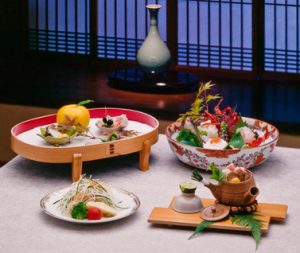
【On the day of business entertainment】
Show respect to key persons
Ask the director of Company A for the toast and ask the director of Company B for the closing remarks.(It is better to check in advance whether they can accept these greetings. )
Stay sharp even if you drink
Entertainment is a part of business. Even if client says “Le’ts loosen up and enjoy!”,you must behave responsibly.If you are in a position to invite, please always look after clients carefully if they are enjoying it.
Smart payment
Check the way of payment with your boss in advance whether your company will pay all or a split bill.If you need to pay, payment will be made before your client notice.
Ask your client for second party
If you invite your client for business entertainment, just in case, prepare the second party in advance.The location of the second party will be close to the venue of the first party.
【Following up】
Express your thanks to client within the next morning.
Tell your client? a feeling of thankfulness as quickly as possible (The best time is the next morning ).The most polite way is a letter, however, recently telephone is mainstream.

Categories
Recent Posts
- I cannot keep up with meetings conducted in Japanese. Are there any good ways to study?
- Are there any good writing materials for business Japanese? (Three keys to developing business Japanese writing skills.)
- Are there any free materials available for studying business Japanese reading?
- Should I read newspapers for reading practice in business Japanese?
- Are there any good business magazines to practice reading business Japanese?
Archives
- August 2022
- June 2022
- May 2022
- April 2022
- March 2022
- February 2022
- January 2022
- October 2021
- January 2021
- August 2020
- July 2020
- June 2020
- May 2020
- April 2020
- March 2020
- February 2020
- January 2020
- December 2019
- November 2019
- October 2019
- September 2019
- August 2019
- July 2019
- June 2019
- May 2019
- April 2019
- March 2019
- February 2019
- January 2019
- December 2018
- November 2018
- October 2018
- September 2018
- August 2018
- July 2018
- June 2018
- May 2018
- April 2018
- March 2018
- February 2018
- January 2018
- November 2017
- October 2017
- July 2017
